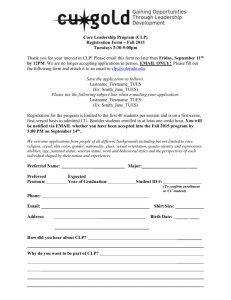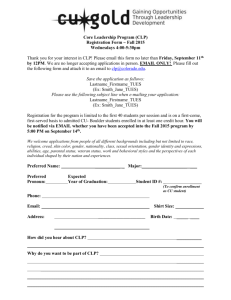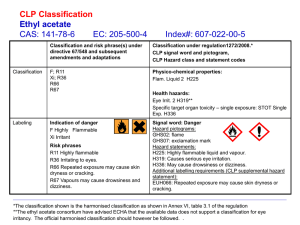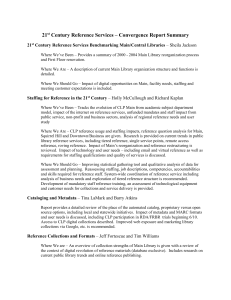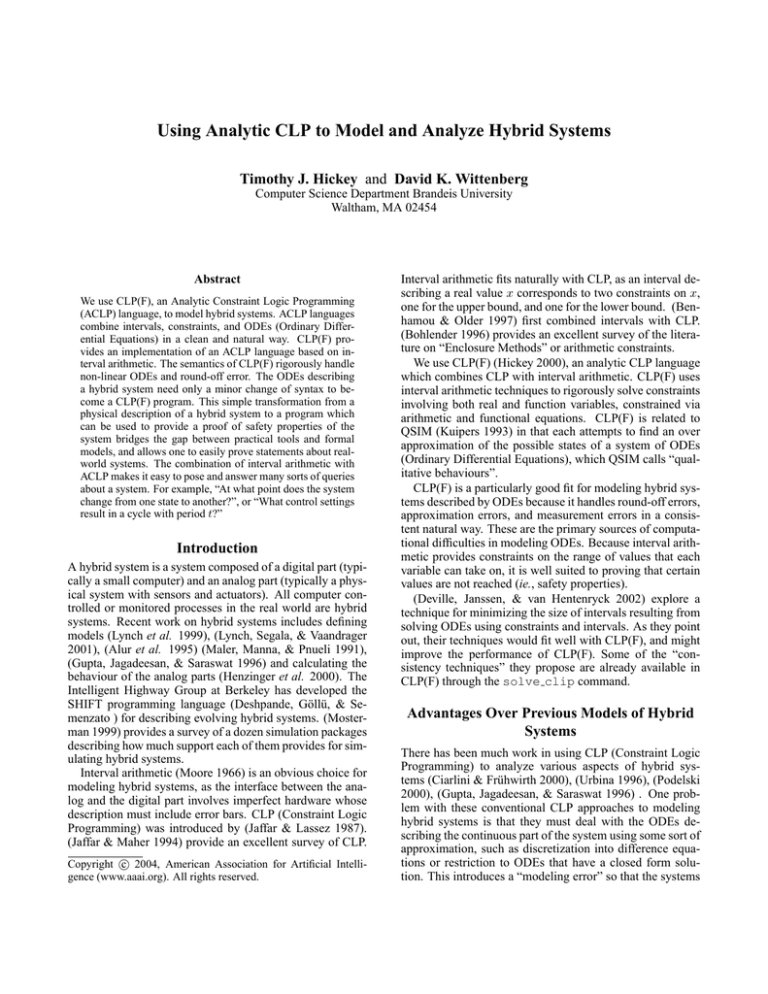
Using Analytic CLP to Model and Analyze Hybrid Systems
Timothy J. Hickey and David K. Wittenberg
Computer Science Department Brandeis University
Waltham, MA 02454
Abstract
We use CLP(F), an Analytic Constraint Logic Programming
(ACLP) language, to model hybrid systems. ACLP languages
combine intervals, constraints, and ODEs (Ordinary Differential Equations) in a clean and natural way. CLP(F) provides an implementation of an ACLP language based on interval arithmetic. The semantics of CLP(F) rigorously handle
non-linear ODEs and round-off error. The ODEs describing
a hybrid system need only a minor change of syntax to become a CLP(F) program. This simple transformation from a
physical description of a hybrid system to a program which
can be used to provide a proof of safety properties of the
system bridges the gap between practical tools and formal
models, and allows one to easily prove statements about realworld systems. The combination of interval arithmetic with
ACLP makes it easy to pose and answer many sorts of queries
about a system. For example, “At what point does the system
change from one state to another?”, or “What control settings
result in a cycle with period t?”
Introduction
A hybrid system is a system composed of a digital part (typically a small computer) and an analog part (typically a physical system with sensors and actuators). All computer controlled or monitored processes in the real world are hybrid
systems. Recent work on hybrid systems includes defining
models (Lynch et al. 1999), (Lynch, Segala, & Vaandrager
2001), (Alur et al. 1995) (Maler, Manna, & Pnueli 1991),
(Gupta, Jagadeesan, & Saraswat 1996) and calculating the
behaviour of the analog parts (Henzinger et al. 2000). The
Intelligent Highway Group at Berkeley has developed the
SHIFT programming language (Deshpande, Göllü, & Semenzato ) for describing evolving hybrid systems. (Mosterman 1999) provides a survey of a dozen simulation packages
describing how much support each of them provides for simulating hybrid systems.
Interval arithmetic (Moore 1966) is an obvious choice for
modeling hybrid systems, as the interface between the analog and the digital part involves imperfect hardware whose
description must include error bars. CLP (Constraint Logic
Programming) was introduced by (Jaffar & Lassez 1987).
(Jaffar & Maher 1994) provide an excellent survey of CLP.
c 2004, American Association for Artificial IntelliCopyright gence (www.aaai.org). All rights reserved.
Interval arithmetic fits naturally with CLP, as an interval describing a real value x corresponds to two constraints on x,
one for the upper bound, and one for the lower bound. (Benhamou & Older 1997) first combined intervals with CLP.
(Bohlender 1996) provides an excellent survey of the literature on “Enclosure Methods” or arithmetic constraints.
We use CLP(F) (Hickey 2000), an analytic CLP language
which combines CLP with interval arithmetic. CLP(F) uses
interval arithmetic techniques to rigorously solve constraints
involving both real and function variables, constrained via
arithmetic and functional equations. CLP(F) is related to
QSIM (Kuipers 1993) in that each attempts to find an over
approximation of the possible states of a system of ODEs
(Ordinary Differential Equations), which QSIM calls “qualitative behaviours”.
CLP(F) is a particularly good fit for modeling hybrid systems described by ODEs because it handles round-off errors,
approximation errors, and measurement errors in a consistent natural way. These are the primary sources of computational difficulties in modeling ODEs. Because interval arithmetic provides constraints on the range of values that each
variable can take on, it is well suited to proving that certain
values are not reached (ie., safety properties).
(Deville, Janssen, & van Hentenryck 2002) explore a
technique for minimizing the size of intervals resulting from
solving ODEs using constraints and intervals. As they point
out, their techniques would fit well with CLP(F), and might
improve the performance of CLP(F). Some of the “consistency techniques” they propose are already available in
CLP(F) through the solve clip command.
Advantages Over Previous Models of Hybrid
Systems
There has been much work in using CLP (Constraint Logic
Programming) to analyze various aspects of hybrid systems (Ciarlini & Frühwirth 2000), (Urbina 1996), (Podelski
2000), (Gupta, Jagadeesan, & Saraswat 1996) . One problem with these conventional CLP approaches to modeling
hybrid systems is that they must deal with the ODEs describing the continuous part of the system using some sort of
approximation, such as discretization into difference equations or restriction to ODEs that have a closed form solution. This introduces a “modeling error” so that the systems
are not computationally sound. One must then reason about
the modeling error outside of the CLP program. Many systems ignore these errors, and leave it up to the user to understand the numerical instabilities. For example, the SHIFT
language (Deshpande, Göllü, & Semenzato ) is very expressive, but it solves non-linear ODEs by using a fourth order
Runge-Kutta algorithm without bounding the error term, and
hence is not rigorous. This sort of numerical analysis (Acton
1996) is very tricky. To require users to understand numerical analysis under pain of getting a wrong answer is to invite
error.
(Hickey 2000) describes CLP(F), an Analytic Constraint
Logic Programming (ACLP) language over the domain of
differentiable functions. In this paper, we show how CLP(F)
allows one to overcome this “modeling error” by allowing
an ODE to be expressed explicitly as a constraint on function variables. The resulting ACLP program has the property
that the results computed using the CLP(F) system are guaranteed to contain all solutions of the ODEs modeled by the
constraints.
One of the major benefits of this approach is that the
problem of analyzing the hybrid system is transformed into
the problem of analyzing the corresponding CLP(F) program. In principle, one should be able to apply well understood program analysis techniques (Smith & Hickey 1990)
to CLP(F) and directly infer provable properties of the corresponding hybrid system. In this paper we describe only the
simpler types of analysis that one can do by directly solving
CLP(F) constraints related to the hybrid system. The primary disadvantage of this approach is that it is very resource
intensive and hence can not currently model systems over a
long modeling period.
To demonstrate the ACLP approach to hybrid system
modeling, we consider the hybrid system of a thermostat
introduced in (Henzinger, Ho, & Wong-Toi 1998). This is
a system consisting of a stirred pot of water with a temperature sensor and a heater in it. When the measured temperature goes above a threshold, the logic circuit shuts off the
heater (after a small delay). Similarly, when the measured
temperature goes below a threshold, the logic circuit turns
on the heater (after a small delay). The safety property in
question is to establish upper and lower bounds for the temperature of the water. The state diagram is given in Figure 2.
Henzinger et al. take a major step towards reliability of
their results by using interval arithmetic in solving the differential equations which describe the system. We improve on
this by modeling the system declaratively as an ACLP program (written in CLP(F) (Hickey 2001)) in which the differential equations appear directly as constraints in the program
and the system is modeled using intervals for all measurements (to model the inevitable error-bars of instruments) as
well as to provide over-approximations to deal with rounding error.
CLP(F)
CLP(F) allows one to constrain functions by functional
equations involving standard arithmetic operations, trigonometric functions, and exponential functions. In addition,
one can constrain a function to take certain values at certain
points and to have a range that lies within an interval.
The CLP(F) system solves analytic constraints by soundly
approximating analytic functions by power series. It can
then introduce arithmetic constraints among the Taylor coefficients of the functions at the endpoints, at points in the
interval, and over the entire range. Since CLP(F) represents
functions as Taylor series, it can easily calculate derivatives
of functions, and enforce constraints on those derivatives.
The CLP(F) solver can handle very complex non-linear differential equations as it is based on a “brute force” reduction
of the analytic constraints into arithmetic constraints which
are solved with a simple interval arithmetic constraint solver.
For example, the following constraint specifies that F is
a function on [0, 1] such that F 0 = F and F (0) = 1 and
F (A) = 2 and F (1) = E and F ([0, 1]) ⊂ [−1000, 1000]:
| ?- type([F],function(0,1)),
{[ ddt(F,1)=F, eval(F,0)=1,
eval(F,A)=2, eval(F,1)=E,
F in [-1000,1000] ]}.
A = 0.6931471... E = 2.7182818...
(760 ms) no
The type predicate is used to declare that F is an infinitely differentiable function on the interval [0, 1]. Thus
F is represented by a list of its Taylor coefficients at 0
(F00 , F01 , F02 , .., F0n ) and at 1 (F10 , F11 , ...) and the ranges
of its derivatives over [0,1] (R0 , R1 , ...), related by the Taylor formula with remainder. The function F is then constrained to be equal to its first derivative (i.e. Fij =
Fi,j+1 , Ri = Ri+1 , and to take the value 1 at 0 (F00 =
1) and to take values in [−1000, 1000] for all x ∈ [0, 1]
(i.e. R0 ⊆ [−1000, 1000]). The variables A and E are
not declared to be functions and hence are real constants
by default. They are constrained so that F (A) = 2 and
F (1) = E (e.g. F10 = E and for each n = 1, 2, . . .,
2 = F00 + F01 A + F02 A2 /2! + . . . + Zn An /n! for some
Zn ∈ Rn ). The constraint solver finds A and E to 7 decimal digits of precision and also finds an interval for F (not
shown here) and specifies intervals Fij for its first 10 derivatives at 0 and 1, and intervals Rj for the range of its first 10
derivatives over [0, 1].
In this paper we use CLP(F) to define higher order constraints which specify that two points lie on a trajectory defined by on ODE. In the simplest model of a thermostat
we use the following CLP(F) procedure, where T0,T1 are
times and A0,A1 are temperatures at those times, A is the
temperature function (so A(T 0) = A0) and Alpha,Beta
are the heat loss and the heater element components of the
ODE for A. The parameter I is a bound on the width of
the interval on which A is defined and is required as CLP(F)
functions must be defined on finite intervals.
ode((T0,A0),[I,[Alpha,Beta]],
A,(T1,A1)) :type([A],function(0,I)),
{[ ddt(A,1) = Alpha * A
+
Beta,
eval(A,0)=A0,
eval(A,T)=A1,
A in [-1.0E100,1.0E100],
T=T1-T0,
T in [0,I]
]}.
The CLP(F) system is easily able to use this definition to
compute (T 1, A1) from (T 0, A0), or, as we will see below,
to use this procedure to find values of the parameters Alpha
and Beta which make the system behave in some desired
fashion.
In this case the ODE is f 0 = af +b, f (0) = a0 , f (t) = a1
which can be solved exactly. CLP(F) can handle trigonometric or exponential functions as well as the linear functions
shown here, but we restrict ourselves to linear functions in
this paper due to space restrictions. Since CLP(F) uses brute
force to model ODEs, it does not perform better on ODEs
which are solvable analytically. See (Hickey & Wittenberg
2003) for examples of CLP(F) working on more complex
functions.
Programs
The program in Figure 1 is one way of implementing a general hybrid system simulator in CLP(F). The first parameter
of the evolve procedure is the initial state of the hybrid
system, which consists of a discrete state S and a continuous state X. The second parameter is a list of values used to
specify the particular hybrid system. The third parameter is
the final (or ending) state of the hybrid system.
evolve(H,C,H,[]).
evolve((S0,X0),C,(S,X)) :statechange((S0,X0),C,S1),
in_trajectory((S1,X0),C,X1),
evolve((S1,X1),C,(S,X)).
that this model assumes that the thermometer is perfect, the
heater produces a constant and perfectly known heat output, the element heats and cools instantly and the physics
of the tank are perfectly modeled by the ODE. Given those
assumptions, they then use interval techniques to eliminate
round off errors in proving safety properties.
z≈h / gfed
Element
Switching
Element
`abc
gfed 0≤z≤εsw/ `abc
gfed
`abc
Cooling
Off
Off
GG
Gc G
O
GG
GG
GG
GM
GG(t)≥2.3
GG
M (t)≥2.3
M (t)≤1.8
GG
GG
M
(t)≤1.8
GG
G#
sw Switching
Element 0≤z≤ε
Element o z≈h `abc
`abc
gfed
`abc
gfed
gfed
o
Heating
On
On
Figure 2: State model allowing thermostat to shut off before
element is warm
CLP(F) Model of the Thermostat
In this section we present two models of a thermostat. The
first simple model demonstrates the key ideas. The second
illustrates how one can easily extend the simple model to a
model that more faithfully represents the real hybrid system
by more closely approximating the physics of the system.
The Simple Model
Figure 1: A general simulator for hybrid systems
Observe that the procedure is simple. It looks for a state
change from (S0,X0) to state S1. Such a change may constrain the values of X0 to lie within narrow intervals. Then
it looks for a new trajectory represented by the continuous
variable X1. Typically, the continuous state will be represented by a pair of dependent variables (T,A) where A
is the value of some ideal system sensor at time T . The
in trajectory procedure looks up the ODE, C, that
should hold in this state and applies that ODE to the initial
values X0 to get the new values X1.
Henzinger’s Model and Analysis
In this section, we present the model of a thermostat with a
delay in switching used by (Henzinger et al. 2000). Henzinger’s model consists of a finite state controller with an
analog input measuring the temperature in the tank. The
controller has a 1-bit output to control a heater in the tank.
The tank always loses heat at a rate directly proportional to
the temperature, and, while the heater is on, is heated at 4 degrees/second. Mathematically, after the heater reaches equilibrium in the on position A0 = −A + 4 and at equilibrium
in the off position A0 = −A. The controller switches the
heater off within one second of the temperature going above
a pre-set value, and turns the heater on within one second
of the temperature dropping below another threshold. Note
Our first CLP(F) model of a thermostat is shown in Figure
3. To clarify the key concepts, this first model assumes there
are only two states: on and off. When the system state is
on, the ODE governing the temperature A is A0 = −A + 4.
When the system state is off, the ODE is A0 = −A. The
system switches from on to off when the temperature rises
above 2.3 and it switches from off to on when it drops below 1.8. The in trajectory procedure models the trajectory by looking up the proper ODE for the current state
and then calling the ODE procedure to constrain the new
state variables (T1,A1). It also adds the constraint that the
temperature range is contained in [-1000, 2.3] (resp.
[1.8,1000]).
This is not needed for our simple example because the
temperature rises monotonically and then falls monotonically and then rises again. With more complex models, the
temperature might not behave so nicely so this constraint
states that no point in the trajectory has passed the threshold
for switching. The statechange procedure simply indicates the condition that signals a state change and provides
the new state. The ode procedure models the specified ODE
as we have described above. Finally the test procedure
shows how this program can be used to model the behavior
of the system. It initializes the list describing the system to
be analyzed and then invokes the evolve procedure.
A simple query (“at what times is the temperature 2?”) to
this system and the resulting answer is shown in Figure 4.
evolve((S0,T0,A0),C,(S1,T1,A1)) :S0=S1,{[T0=T1,A0=A1]}.
evolve((S0,X0),C,(S,X)) :statechange((S0,X0),C,S1),
in_trajectory((S1,X0),C,X1),
evolve((S1,X1),C,(S,X)).
in_trajectory((S0,(T0,A0)),
[I, Min, Max, ODEs],(T1,A1)) :member(S0=ODE,ODEs), {T=T1-T0,T=<I},
ode((T0,A0),[T,ODE],A,(T1,A1)),
( (S0=on,
{[A in [-1000,Max] ]});
(S0=off,
{[A in [Min,1000]]})).
statechange((S0,(T0,A0)),
[_I, Min, Max, ODEs],S1) :( (S0=on,
{A0= Max}, S1=off);
(S0=off
{A0=Min }, S1=on) ).
ode((T0,A0),[I,[Alpha,Beta]]
,A,(T1,A1)) :type([A],function(0,I)),
{[ ddt(A,1) = Alpha * A + Beta,
eval(A,0)=A0,
eval(A,T)=A1,
A in [-1.0E100,1.0E100],
T=T1-T0,
T in [0,I]]}.
test(S,X) :C=[ 2.0,
1.8, 2.3,
[on=[-1,4],off=[-1,0]]],
in_trajectory((on,(0,2)),C,X0),
evolve((on,X0),C,(S,X)).
evolve((S,T,A,Z),_,(S1,T1,A1,Z1)) :S=S1,{[T=T1,A=A1,Z=Z1]}.
evolve((S0,X0),C,(S,X)) :statechange((S0,X0),C,S1),
in_trajectory((S1,X0),C,X1),
evolve((S1,X1),C,(S,X)).
in_trajectory((S0,(T0,A0,_Z0)),
[Step, Min, Max, Delay, Stime, ODEs],
(T1,A1,Z1)) :member(S0=ODE,ODEs),
{Z1=T, T=T1-T0, T=<Step},
ode((T0,A0),[T,ODE],A,(T1,A1)),
((S0=on,
{[A in [-1000,Max] ]});
(S0=sw0,
{[T=<Delay]});
(S0=cooling, {[T<Stime,
A in [Min,1000]]});
(S0=off,
{[A in [Min,1000] ]});
(S0=sw1,
{[T=<Delay]});
(S0=heating, {[T<Stime,
A in [-1000,Max]]})).
statechange((S0,(_T0,A0,T)),
[_S, Min, Max, Delay,Stime,_O],S1) :((S0=on,
{A0=Max},
S1 = sw0);
(S0=sw0,
{T=Delay}, S1=cooling);
(S0=cooling,{T=Stime}, S1=off);
(S0=cooling,{A0=Min},
S1=sw1);
(S0=off,
{A0=Min }, S1=sw1);
(S0=sw1,
{T=Delay}, S1=heating);
(S0=heating,{T=Stime}, S1= on);
(S0=heating,{A0=Max},
S1= sw0)).
Figure 3: Simplest CLP(F) model of a thermostat
One subtle point about this model is that the CLP(F)
solver will only work effectively if a finite step size is
given explicitly (this is the I parameter appearing in the
in trajectory and ode procedures. If the step size is
too large, then the CLP(F) solver will return very wide, unhelpful intervals for all variables.
One approach to handling this is to introduce pseudo
states (on,n), (off,n), where n is an integer representing the number of full steps that have been taken on the
current trajectory in the current state. The continuous part
can be modeled as (t,a,z) where t is the total elapsed
time, a is the temperature at time t, and z is the time relative
to the current step. Such an extension of the current technique is straightforward and we do not show it here due to
space limitations.
|
A
A
A
?- test(S,(T,A)),{A=2}.
= 2, S = on, T = 0 ?
= 2, S = off, T = 0.3022808718... ? ;
= 2, S = on, T = 0.5029515673... ?
ode((T0,A0),
[I,[Alpha,Beta,Gamma,Delta]],
A,(T1,A1)) :type([A,B],function(0,I)),
{[ ddt(A,1) = Alpha*A +Beta +Gamma*B,
ddt(B,1) = Delta*B,
eval(A,0)=A0,
eval(A,T)=A1,
eval(B,0)=1,
A in [-1.0E100,1.0E100],
B in [-1.0E100,1.0E100],
T=T1-T0,
T in [0,I]
]}.
test(S,X,D) :C=[ 2.0,
1.8, 2.3, 0.05, 0.1,
[on=[-1,4, 0,1],off=[-1,0,0,1],
sw0=[-1,4, 0,1],sw1=[-1,0,0,1],
heating=[-1,4,-4,D],
cooling=[-1,0, 4,D] ]],
in_trajectory((on,(0,2,0)),C,X0),
evolve((on,X0),C,(S,X)).
Figure 5: More Complete Model of Thermostat
Figure 4: Query to Simple Model - When is Temp = 2?
A More Realistic Model
In the example shown in Figure 5, we refine the previous model by using six states
on,sw0,cooling,off,sw1,heating corresponding to the states in Henzinger’s model. The model also
represents the continuous state as a triple T, A, Z where
T is the total elapsed time, A is the temperature at time
T , and Z is the time since the system entered the current state. The Z parameter is needed to implement the
“switching” specification which states that the system waits
some amount of time after the threshold is passed before
switching on/off the heating element. Likewise, the time in
which the system is heating/cooling before it “jumps” to
the maximum/minimum value is given by a time unit. This
represents a discontinuity in the model since the heating
temperature is assumed to immediately rise to the maximum
at the end of the element-heating period.
The sw0,sw1 states represent times when the system is
waiting before switching the heating element on or off. The
heating,cooling states represent times when the element is warming up or cooling down. The on,off states
represent times when the element is fully on or off. Observe
that the ODEs for each state are specified in the variable C
of the test procedure. Also, observe that the switching conditions are given declaratively in the statechange procedure. Finally, note that the system is assumed to be modeled
by the following more complex non-linear family of ODEs,
where the parameters (α, β, γ, δ) vary from state to state:
∀t ∈ [0, I] A0 (t) = αA(t) + β + γB(t)
∀t ∈ [0, I] B 0 (t) = δB(t)
T = T 1 − T 0, 0 ≤ T ≤ I
A(0) = A0, A(T ) = A1, B(0) = 1
A([0, I]), B([0, I]) ⊂ [−10100 , 10100 ]
The variable B represents the heat transfer from the heating
element and the rate at which it heats and cools depends on
its temperature and on the parameter δ.
The following code shows a more interesting example in
which the model is used to find all values of the ODE parameter δ in the range [−10, −5] for which the system evolves
to the state with S=off and A = 2 in exactly 0.5 seconds.
| ?- {D in [-10,-5],T=1/2,A=2}, S=off,
test(S,(T,A,Z),D),narrow_all(10000000).
A = 2
D = -8.3533433047...e+00
S = off
T = 0.5
Z = 1.87481070502225...e-01 ?
(10820 ms) yes
Conclusions
Strengths of CLP(F)
A novel aspect of the ACLP approach to hybrid system analysis is that it establishes a close correspondence between the
semantics of a particular class of constraint programs and the
behavior of hybrid systems providing several advantages:
The simple mapping means that one needn’t worry about
the “translation” from ODEs to CLP(F). Interval techniques
guarantee that calculated safety properties are correct, and
protect against round-off errors, while also providing a natural technique to handle error bars on physical measurements.
While other hybrid system models can be extended to handle error bars in measurements, CLP(F) handles them naturally with no extra effort either in specifying them or in
the calculation. A further advantage is that CLP(F) handles
non-linear ODEs directly and soundly. CLP(F) also allows
one to incrementally refine a model as one learns more about
the physics of a system. At areas near a transition, one need
not understand the details of the transition, but can simply
bound the behaviour in that area, and get sound results. As
one learns more about the physics, one can refine the model.
In addition CLP(F) is a very expressive language. It is
easy to state problems involving finding values of the control parameters which result in specified behavior. Similarly, finding the time of state transitions is a simple matter
of describing the transition as a constraint. Once the problem is stated, the underlying Prolog interpreter automatically
solves it. Other ODE approaches often require an explicit
binary search to find such times.
Limitations and Future Work
Currently there are several limitations on using CLP(F) to
model hybrid systems. Each of them is an obvious possibility for future work: It would be helpful to develop more
efficient interpreters for CLP(F) to handle very large complex systems. So far we have put almost no work into the
efficiency of CLP(F), so there is a great deal of room for
improvement here. We would like to extend this work to hybrid systems where the sensors are governed by PDEs rather
than ODEs. Further efficiency improvements would come
from developing primitive implementations of the ode procedures so that one does not need to use the full power of
ACLP (and its accompanying inefficiencies).
We would like to develop more realistic models of hybrid
systems using this approach.
CLP is not complete. If the search is bounded (e.g. there
is a limit on the time parameter), then the entire search space
will be traversed via backtracking and the incompleteness of
Prolog is not an issue. The incompleteness of the CLP solver
is however an issue whose consequence is that we do not
know for certain whether any particular answer constraint
actually contains a solution.
There is room for improvement in the heuristics of the
underlying constraint solver. Since the CLP system guarantees soundness, extra attempts to narrow cannot introduce
errors, but they do take time. Better heuristics could improve performance, both by reducing the running time and
by narrowing the resulting intervals.
This paper has demonstrated that Analytic Constraint
Logic Programming provides a promising approach to modeling hybrid systems by providing a program whose semantics precisely match the behavior of the hybrid system. Further research is needed to see if such an approach can be
scaled up to real-life systems.
References
Acton, F. S. 1996. Real computing made real: Preventing
Errors in Scientific and Engineering calculations. Princeton, New Jersey: Princeton University Press.
Adams, E., and Kulisch, U., eds. 1993. Scientific Computing with Automatic Result Verification. Academic Press.
Alur, R.; Courcoubetis, C.; Halbwachs, N.; Henzinger,
T. A.; Ho, P.-H.; Nicollin, X.; Olivero, A.; Sifakis, J.; and
Yovine, S. 1995. The algorithmic analysis of hybrid systems. Theoretical Computer Science 138:3–34.
Benhamou, F., and Older, W. J. 1997. Applying interval
arithmetic to real, integer, and boolean constraints. Journal
of Logic Programming 32(1):1–24.
Bohlender, G. 1996. Literature on enclosure methods and related topics. Technical report, Institut für
Angewandte Matematik, Universität Karlsruhe, Postfach
6980, D-76128 Karlsruhe, Germany. http://www.unikarlsruhe.de/∼Gerd.Bohlender/litlist.html an earlier version appeared in (Adams & Kulisch 1993).
Ciarlini, A. E., and Frühwirth, T. 2000. Automatic derivation of meaningful experiments for hybrid systems. In
ACM SIGSIM Conference on AI, Simulation and Planning
(AIS ’2000).
Deshpande, A.; Göllü, A.; and Semenzato, L. The
SHIFT Programming Language and Run-time System for
Dynamic Networks of Hybrid Automata. Department
of Electrical Engineering and Computer Sciences; University of California at Berkeley, Berkeley, CA 94720.
http://www.path.berkeley.edu/shift/doc/ieeshift.ps.gz.
Deville, Y.; Janssen, M.; and van Hentenryck, P. 2002.
Consistency techniques in ordinary differential equations.
Constraints 7(3):289–315.
Gupta, V.; Jagadeesan, R.; and Saraswat, V. 1996. Hybrid
cc, hybrid automata and program verification. In Alur, R.;
Henzinger, T. A.; and Sontag, E. D., eds., Hybrid Systems
III: Verification and Control, volume 1066 of LNCS, 52–
63. Springer Verlag.
Henzinger, T. A.; Horowitz, B.; Majumdar, R.; and WongToi, H. 2000. Beyond H Y T ECH: Hybrid systems analyis using interval numerical methods. In Lynch, N., and
Krogh, B. H., eds., Hybrid Systems: Computation and
Control (HSCC 2000), volume 1790 of LNCS, 130–144.
Springer Verlag.
Henzinger, T. A.; Ho, P.-H.; and Wong-Toi, H. 1998. Algorithmic analysis of nonlinear hybrid systems. IEEE Transactions on Automatic Control 43:540–554.
Hickey, T. J., and Wittenberg, D. K. 2003. Rigorous modeling of hybrid systems using interval arithmetic
constraints. Technical Report CS-03-241, Brandeis University.
http://www.cs.brandeis.edu/∼dkw/papers/cs03241.pdf, accepted to HSCC 04.
Hickey, T. J. 2000. Analytic constraint solving and interval
arithmetic. In POPL’00 ACM SIGPLAN-SIGACT Symposium on Principles of Programming Languages, 338–351.
published as vol. 27 of SIGPLAN notices.
Hickey, T. J. 2001. Metalevel interval arithmetic and
verifiable constraint solving.
Journal of Functional
and Logic Programming 2001(7).
http://danae.unimuenster.de/lehre/kuchen/JFLP/articles/2001/S0102/JFLP-A01-07.pdf.
Jaffar, J., and Lassez, J. 1987. Constraint logic programming. In Proceedings 14th ACM Symposium on the Principles of Programming Languages, 111–119.
Jaffar, J., and Maher, M. J. 1994. Constraint logic programming: A survey. Journal of Logic Programming
19/20:503–581.
Kuipers, B. J. 1993. Qualitative simulation: Then and now.
Artificial Intelligence 59:133–140.
Lynch, N.; Segala, R.; Vaandrager, F. W.; and Weinberg, H.
1999. Hybrid I/O automata. Technical Report CSI-R9907,
Computing Science Institue Nijmegen; Faculty of Mathematics and Informatics; Catholic University of Nijmegen,
Toernooivveld 1; 6525 ED Nijmegen; The Netherlands.
Lynch, N.; Segala, R.; and Vaandrager, F. 2001. Hybrid I/O automata revisited. In Benedetto, M. D. D., and
Sangiovanni-Vincentelli, A., eds., Hybrid Systems: Communication and Control, volume 2034 of LNCS, 403–417.
Springer Verlag.
Maler, O.; Manna, Z.; and Pnueli, A. 1991. From timed to
hybrid systems. In de Bakker, J.; Huizing, C.; de Roever,
W.; and Rozenberg, G., eds., Real-Time: Theory in Practice, volume 600 of LNCS, 447–484. Mook, The Netherlands: Rex Workshop.
Moore, R. E. 1966. Interval Analysis. Prentice-Hall.
Mosterman, P. J. 1999. An overview of hybrid simulation
phenomena and their support by simulation packages. In
Vaandrager, F. W., and van Schuppen, J. H., eds., Hybrid
Systems: Computation and Control, volume 1569 of LNCS,
165–177. Springer Verlag.
Podelski, A. 2000. Model checking as constraint solving.
In Palsberg, J., ed., Proceedings of SAS’2000: Static Analysis Symposium.
Smith, D. A., and Hickey, T. J. 1990. Partial evaluation
of a CLP language. In Debray, S., and Hermenegildo, M.,
eds., Proceedings of the 1990 North American Conference
in Logic Programming, 119–138.
Urbina, L. 1996. Analysis of hybrid systems in CLP(R). In
Freuder, E. C., ed., Principles and Practice of Constraint
Programming – CP96, volume 1118 of LNCS, 451–467.
Springer Verlag.

